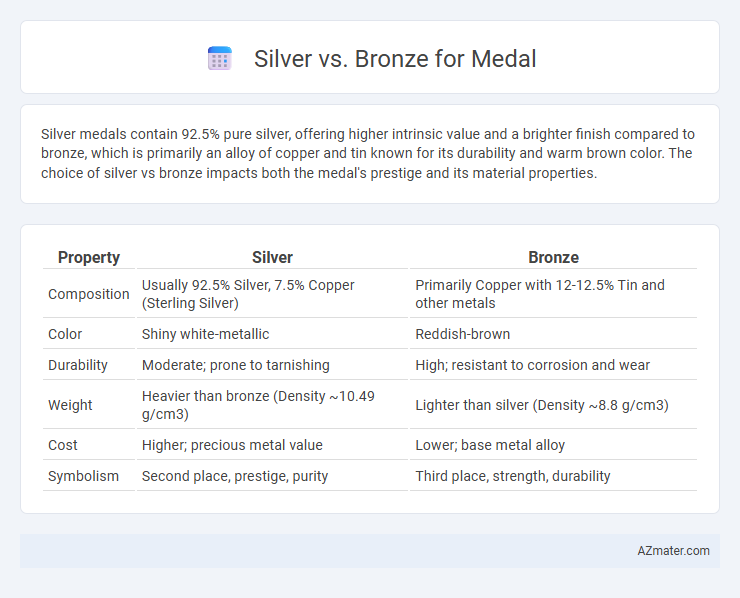Silver medals contain 92.5% pure silver, offering higher intrinsic value and a brighter finish compared to bronze, which is primarily an alloy of copper and tin known for its durability and warm brown color. The choice of silver vs bronze impacts both the medal's prestige and its material properties.
Table of Comparison
| Property | Silver | Bronze |
|---|---|---|
| Composition | Usually 92.5% Silver, 7.5% Copper (Sterling Silver) | Primarily Copper with 12-12.5% Tin and other metals |
| Color | Shiny white-metallic | Reddish-brown |
| Durability | Moderate; prone to tarnishing | High; resistant to corrosion and wear |
| Weight | Heavier than bronze (Density ~10.49 g/cm3) | Lighter than silver (Density ~8.8 g/cm3) |
| Cost | Higher; precious metal value | Lower; base metal alloy |
| Symbolism | Second place, prestige, purity | Third place, strength, durability |
Overview: Silver vs Bronze Medals
Silver medals represent second-place achievements, signaling a higher performance level than bronze medals, which denote third place in competitions. The distinction between silver and bronze medals highlights the difference in ranking and often reflects closer competition margins. Collectors and athletes value silver medals for their association with near-top accomplishments and advanced skill recognition.
Historical Significance of Silver and Bronze Medals
Silver medals have historically symbolized second place prestigious achievements, tracing back to ancient Olympic Games where silver represented purity and valor. Bronze medals, awarded for third place, originated from the Roman era as a durable and affordable metal, signifying resilience and practicality. Both metals carry profound historical significance, reflecting cultural values and societal recognition in competitive events.
Symbolism Behind Silver and Bronze Awards
Silver medals symbolize second place and are associated with qualities like sophistication, clarity, and resilience, often representing a dignified achievement just shy of the highest honor. Bronze medals, awarded for third place, embody durability, strength, and the value of perseverance, reflecting recognition for commendable performance amid stiff competition. Both metals carry historical significance and cultural meanings that underscore the honor and respect conferred upon the recipients.
Psychological Impact of Winning Silver vs Bronze
Winning a silver medal often triggers feelings of disappointment and frustration due to narrowly missing the top position, a phenomenon linked to counterfactual thinking where athletes imagine winning gold. Bronze medalists generally experience greater satisfaction and pride as they have secured a podium finish, perceiving their achievement more positively. Psychological studies reveal that the silver medal's proximity to first place intensifies regret, while the bronze medal acts as a tangible symbol of success and accomplishment.
Medal Placement and Its Perceived Value
Silver medals are awarded for second place, representing high achievement just below the winner, while bronze medals recognize third place, symbolizing commendable performance. The perceived value of a silver medal often carries a sense of narrowly missed victory, which can motivate athletes to improve, whereas bronze signifies a respected accomplishment and a podium finish. Both medals highlight excellence but differ in public and personal perceptions of success and recognition.
Athlete Experiences: Silver vs Bronze Recipients
Silver medal recipients often experience a mix of pride and frustration, reflecting on their near-top performance and narrowly missing gold. Bronze medalists frequently express relief and joy, valuing their podium placement as a significant achievement and recognition of their hard work. The psychological impact differs, with silver winners sometimes facing greater pressure for future success, while bronze winners often find renewed motivation and encouragement.
Public and Media Perception of Second vs Third Place
Silver medals often symbolize near-victory and are frequently associated with both pride and slight disappointment, reflecting the public's recognition of high achievement but missed gold. Bronze medals, representing third place, tend to carry a perception of solid accomplishment and resilience, often celebrated for securing a podium spot despite the lower ranking. Media coverage tends to highlight silver medalists with narratives of "almost winning," while bronze recipients receive praise for overcoming adversity and securing a historical mark.
Notable Moments: Silver and Bronze Achievements in Sports
Silver and bronze medals highlight remarkable resilience and skill in sports, often marking athletes' breakthrough performances on the world stage. Notable silver achievements include Usain Bolt's 2015 World Championships 200m, where an unexpected second place showcased fierce competition, while bronze moments like Michael Phelps' 2012 Olympic 200m butterfly reflect enduring legacy and determination. These podium finishes celebrate perseverance and symbolize the narrow margins between victory and defeat in high-stakes competitions.
The Rarity and Prestige of Silver vs Bronze Medals
Silver medals hold greater prestige and rarity compared to bronze due to their historical association with second place in elite competitions such as the Olympics. The material value of silver, being a precious metal with intrinsic worth, elevates its status above bronze, which is an alloy of copper and tin with lower market value and symbolic significance. Collectors and athletes alike recognize silver medals as a symbol of exceptional achievement, whereas bronze medals are often viewed as commendable but more common tokens of third-place finishes.
Conclusion: Which Medal Carries More Meaning?
Silver medals signify near-victory and resilience, often representing athletes who push beyond limits yet fall just short of ultimate triumph. Bronze medals embody perseverance and achievement, acknowledging competitors who have excelled amid fierce competition to earn recognition. The meaning of each medal depends on context, but silver often symbolizes narrowly missed glory, while bronze reflects commendable success.

Infographic: Silver vs Bronze for Medal
 azmater.com
azmater.com